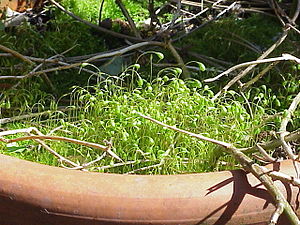Weather-indicating rotary moss
| Weather-indicating rotary moss | ||||||||||||
|---|---|---|---|---|---|---|---|---|---|---|---|---|

Weather-indicating rotary moss ( Funaria hygrometrica ) |
||||||||||||
| Systematics | ||||||||||||
|
||||||||||||
| Scientific name | ||||||||||||
| Funaria hygrometrica | ||||||||||||
| Hedw. |
The weather-indicating rotary moss ( Funaria hygrometrica ), also known as the real rotary moss, is a pioneer moss that can quickly colonize nutrient-rich, disturbed locations. The species is autocratic ( antheridia and archegonia on different branches on the same plant).
It is considered to be the cultural successor of humans and is one of the most physiologically studied mosses . The name refers to the hygroscopic seta , which turns jerkily when it rains or when it dries out. This should encourage the spores to spread.
features
The weather-indicating rotary moss grows in groups or in extensive, more or less dense lawns. It forms pale green, or dirty green to yellowish green, bud-shaped plants. The rungs are no longer than 15 mm. The leaves are inclined bud-shaped at the tip, hollow, ovate, lanceolate to ovate-spatulate, briefly pointed. Rarely do these have a very short rib that usually ends in the tip of the leaf. The male plants form antheridia at the tip of the leaf rosette . The lamina cells are rectangular or elongated hexagonal shaped, about 50 to 100 µm long and 25 to 50 µm wide. In the upper part of the leaf they are at least rectangular, but never rounded. The seta, which is up to 4 cm long, is upright or slightly curved at the top and twisted or twisted. The asymmetrical, curved capsules are inclined or hanging, crooked, pear-shaped, dry, clearly furrowed and brownish in color. They have a long neck. The peristome is doubled and always well developed. The dome-shaped capsule lid has no point, is smooth and sits on the base of the anulus of the capsule. The hood-shaped kalyptra is beaked and sits crooked on the capsule. The mostly smooth spores are about 12-22 µm in size on average. Sporogons are always abundant. The maturity can take place throughout the year.
The scientific name refers to the property of the capsule stem (the seta) to turn like a rope when it is dry: funis (Latin) = rope, rope; hygrometrica = measuring moisture.
Distribution and location
The weather indicating rotary moss is widespread worldwide. It is a common moss in Central Europe . It colonizes open, nutrient-rich, mostly bright, fresh to moist locations and prefers sandy, loamy, clayey soil, humus , peat , gravel or gravel. Natural locations are obviously fire spots and muddy banks of water. Otherwise it is particularly to be found in disturbed ruderal areas , on rubble sites, on garbage dumps, in gardens and heavily used agricultural fields. The occurrences are mostly inconsistent and short-lived.
The real rotary moss is parasitized by the smooth spore moss-bristle ( Neottiella hetieri ).
literature
- Jan-Peter Frahm , Wolfgang Frey : Moosflora (= UTB . 1250). 4th, revised and expanded edition. Ulmer, Stuttgart 2004, ISBN 3-8252-1250-5 .
- Martin Nebel, Georg Philippi (ed.): The mosses of Baden-Württemberg. Volume 1: General part, special part (Bryophytina I, Andreaeales to Funariales). Ulmer, Stuttgart 2000, ISBN 3-8001-3527-2 .
- Volkmar Wirth , Ruprecht Düll : Color Atlas of Lichen and Moss. Ulmer, Stuttgart 2000, ISBN 3-8001-3517-5 .
Web links
Individual evidence
- ↑ Martin B. Ellis, J. Pamela Ellis: Microfungi on land plants. An identification handbook. Croom Helm, London et al. 1985, ISBN 0-7099-0950-0 .

